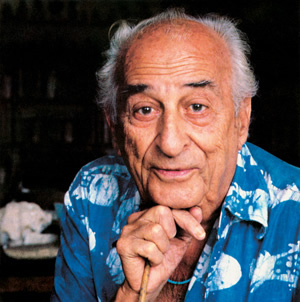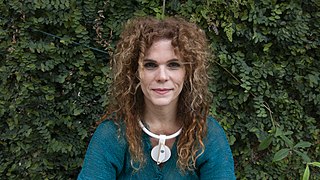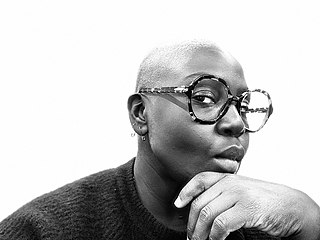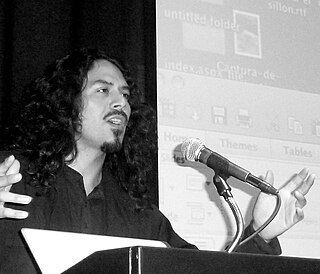Related Research Articles
Mayan or Maya mythology is part in of Mesoamerican mythology and comprises all of the Maya tales in which personified forces of nature, deities, and the heroes interacting with these play the main roles. The legends of the era have to be reconstructed from iconography. Other parts of Mayan oral tradition are not considered here.
The Mayan architecture of the Maya civilization spans across several thousands of years, several eras of political change, and architectural innovation before the Spanish colonization of the Americas. Often, the buildings most dramatic and easily recognizable as creations of the Maya peoples are the step pyramids of the Terminal Preclassic Maya period and beyond. Based in general Mesoamerican architectural traditions, the Maya utilized geometric proportions and intricate carving to build everything from simple houses to ornate temples. This article focuses on the more well-known pre-classic and classic examples of Maya architecture. The temples like the ones at Palenque, Tikal, and Uxmal represent a zenith of Maya art and architecture. Through the observation of numerous elements and stylistic distinctions, remnants of Maya architecture have become an important key to understanding their religious beliefs and culture as a whole.
The Art Guys (Michael Galbreth and Jack Massing are a collaborative artist team based in Houston, Texas.

Mayan Revival is a modern architectural style popular in the Americas during the 1920s and 1930s that drew inspiration from the architecture and iconography of pre-Columbian Mesoamerican cultures.
Brígida Baltar was a Brazilian visual artist. Her work spanned across a wide range of mediums, including video, performance, installation, drawing, and sculpture. She was interested in capturing the ephemeral in her artwork.

Héctor Julio Páride Bernabó was an Argentine-Brazilian artist, researcher, writer, historian and journalist. His nickname and artistic name, Carybé, a type of piranha, comes from his time in the scouts. He died of heart failure after the meeting of a candomblé community's lay board of directors, the Cruz Santa Opô Afonjá Society, of which he was a member.

Laura Lima is a contemporary Brazilian artist who lives and works in Rio de Janeiro. Since the 1990s, Lima has discussed in her works the matter of alive beings, among other topics. Her works can be found in the collections of institutions such as Bonniers Konsthall, Stockholm, Sweden; Inhotim Institute, Brumadinho, Brazil; MAM - Museum of Modern Art, São Paulo, Brazil; Migros Museum für Gegenwartskunst, Zurich, Switzerland; Pinacoteca of the State of São Paulo, Brazil; Itaú Cultural, São Paulo, Brazil; Pampulha Museum of Art, Belo Horizonte, Brazil; National Museum of Fine Arts, Rio de Janeiro, Brazil; Hammer Museum, Los Angeles, USA; MASP - Museum of Art of São Paulo, Brazil, among others.
Koo Jeong A is a South-Korean born mixed-media and installation artist.
Luisa Lambri is an Italian artist working with photography and film, based in Milan. Her photographs are often based on architecture and abstraction.

Antonio José de Barros Carvalho e Mello Mourão, known professionally as Tunga, was a Brazilian sculptor and performance artist. Tunga was born in Palmares, Pernambuco, Brazil.
Gisele Camargo was born on July 11, 1970, in Rio de Janeiro, Brazil. She is a Brazilian painter and photographer who works in photography, video, and painting. She is best known for her pictorial meditations on urban and cinematic landscapes. She was formally trained at the Escola de Belas-Artes (EBA) of the Universidade Federal do Rio de Janeiro in the late 1990s. While in the institution, Camargo was part of a group of students who concentrated on issues of urban experience and visual culture in Rio de Janeiro. Camargo was different from the rest of her classmates, while they engaged mostly with multimedia language she remained a painter, with sporadic forays into photography and photocollage.

Rosângela Rennó Gomes is a Brazilian artist who lives and works in Rio de Janeiro. Her work consists of photographic images from public and private archives that question the nature of an image and its symbolic value. With the use of photographs, installations and objects, she appropriates and sheds new light on an anonymous body of photographs and negatives found mostly in flea markets, family albums, newspapers and archives. Rennó's interest in discarded images and habit of collecting were decisive in establishing her work strategies.
Franklin Sirmans is an American art critic, editor, writer, curator and has been the director of the Pérez Art Museum Miami (PAMM) since October 2015. His initiatives there include ensuring that PAMM's art program reflects the community in Miami and securing donations. In his first six months at PAMM, he managed to secure the largest donation of works in the museum's short history, over a hundred pieces of art were donated by Design District developer Craig Robins.
Livia Corona Benjamin is a Mexican artist that centers her work on the relationship of human experience and the man-made. Her recent work is artisanal but combines multi genre practice of the developing world and new innovations.

Autumn Knight is an American interdisciplinary artist working with performance, installation, and text from Houston, Texas who lives and works in New York City.

William Cordova is a contemporary cultural practitioner and interdisciplinary artist currently residing between Lima, Peru; North Miami Beach, Florida; and New York.
Luisa Malzone Strina is a Brazilian art gallerist and art collector. Her gallery, Galeria Luisa Strina, is the oldest contemporary art gallery in Brazil.
Guadalupe Maravilla, formerly known as Irvin Morazan, is a transdisciplinary visual artist, choreographer, and healer. At the age of eight, Maravilla was part of the first wave of unaccompanied, undocumented children to arrive at the United States border in the 1980s as a result of the Salvadoran Civil War. In 2016, Maravilla became a U.S. citizen and adopted the name Guadalupe Maravilla in solidarity with his undocumented father, who uses Maravilla as his last name. As an acknowledgment to his past, Maravilla grounds his practice in the historical and contemporary contexts belonging to undocumented communities and the cancer community. Maravilla's studio is located in Brooklyn, New York.
Alexandre da Cunha is a Brazilian-British artist, who produces sculpture and wall mounted works, often using found objects. His works have been exhibited around the world, and are located in several major public collections.

Galería MUY ) is a cultural space devoted to contemporary art by Maya peoples and Zoque people. The name “MUY” comes from the Tzotzil language and is the root of the word meaning “pleasure”. The cultural center is located in a clay house in a central neighborhood in the city of San Cristóbal de las Casas and consists of a large patio, gallery spaces, a collection of over 150 Mayan and Zoque artifacts, a residence house, and a painting and ceramics production studio.
References
- ↑ "Clarissa Tossin, Made in L.A. 2014", Hammer Museum.
- ↑ Newbury, Susanna Phillips. "Clarissa Tossin: Falling from Earth", CAA Reviews, 3 April 2023.
- ↑ "Clarissa Tossin, Made in L.A. 2014", Hammer Museum.
- ↑ Klaasmeyer, Kelly. "Relentless Sun: The Images of Clarissa Tossin" Houston Press, 29 May 2013.
- ↑ "Brasília, Cars, Pools and Other Modernities", Artpace.
- ↑ Frater, Sally. “Traversing Geographies, Collapsing Architectures“, X-TRA vol. 16 no. 3, Spring 2014.
- ↑ "Clarissa Tossin, Made in L.A. 2014", Hammer Museum.
- ↑ "Streamlined: Belterra, Amazónia/Alberta, Michigan", Sicardi Gallery.
- ↑ "Clarissa Tossin: Meeting of Waters", Blanton Museum of Art.
- ↑ Wymann, Sandrine. "Clarissa Tossin: Circumnavigation towards exhaution", La Kunsthalle Mulhouse, June 2021.
- ↑ "Clarissa Tossin Falling From Earth", MCADenver.
- ↑ Huete, Betsy. "In Houston, Artist Clarissa Tossin Ponders the Colonial Implications of the 21st-Century Space Race", ARTnews, 18 March 2022.
- ↑ "Clarissa Tossin Falling From Earth", MCADenver.
- ↑ Wymann, Sandrine. "Clarissa Tossin: Circumnavigation towards exhaustion", La Kunsthalle Mulhouse, June 2021.
- ↑ Murray, Yxta Maya. "Clarissa Tossin", Artforum, April 2022.
- ↑ Belchior, Camila. "Clarissa Tossin" Artforum, February 2019.
- ↑ Mizota, Sharon. "Review: Nearly a century later, a video artist follows Frank Lloyd Wright’s Mayan footsteps", LA Times, 15 October 2017.
- ↑ "Clarissa Tossin at Commonwealth & Council", Art Viewer, 26 October 2017.
- ↑ Kramer, Kaitlyn A. "Indigeneity in the Present Tense: Pacha, Llaqta, Wasichay at the Whitney", BOMB, 12 September 2018.
- ↑ "Clarissa Tossin - The Mayan", Commonwealth and Council.
- ↑ Steinhauer, Jillian. "What to See in New York Art Galleries This Week - Pacha, Llaqta, Wasichay", NY Times, 13 September 2018.
- ↑ Fernández, Mariana. "Permission to Return Home: Clarissa Tossin Interviewed by Mariana Fernández", BOMB, 6 September 2022.
- ↑ "MOCA Artist Film Series: Clarissa Tossin", MOCA
- ↑ "Mojo’q che b’ixan ri ixkanulab’ / Antes de que los volcanes canten / Before the Volcanoes Sing - Clarissa Tossin", EMPAC.
- ↑ Newbury, Susanna Phillips. "Clarissa Tossin: Falling from Earth", CAA Reviews, 3 April 2023.
- ↑ "Clarissa Tossin: to take root among the stars", Frye art Museum.
- ↑ "Vulneravelmente Humano / Vulnerably Human", Galeria Luisa Strina.
- ↑ "Falling From Earth", Museum of Contemporary Art Denver.
- ↑ "Disorientation Towards Collapse", Commonwealth and Council.
- ↑ "Circumnavigation towards exhaustion", La Kunsthalle Mulhouse.
- ↑ "Off the Wall: Clarissa Tossin, The 8th Continent", Moody Center for the Arts, Rice University.
- ↑ "Clarissa Tossin: Future Fossil", Harvard Radcliffe Institute.
- ↑ "21st Century Wisdom: Healing Frank Lloyd Wright's textile block houses", 18th Street Arts Center.
- ↑ "Clarissa Tossin: Meeting of Waters", Blanton Museum of Art.
- ↑ "Azul Maia / Maya Blue", Galeria Luisa Strina.
- ↑ "The Mayan", Commonwealth and Council.
- ↑ "Clarissa Tossin: Stereoscopic Vision", Ezra and Cecile Zilkha Gallery, Wesleyan University.
- ↑ "Streamlined: Belterra, Amazónia/Alberta, Michigan", Sicardi Gallery.
- ↑ "Brasília Teimosa", Fundação Joaquim Nabuco.
- ↑ "Transplantado (VW Brasilia)", Galeria Luisa Strina.
- ↑ "Brasília, Cars, Pools & Other Modernities", Artpace.
- ↑ "Clarissa Tossin at Window into Houston and Sicardi Gallery", Arts and Culture Texas, 24 May 2013.
- ↑ "Gasto / Spent", Galeria Luisa Strina.
- ↑ "Born in Flames: Feminist Futures", Bronx Museum of the Arts.
- ↑ Cardwell, Erica N. "Born in Flames Trailblazes a Collective Feminist Future", FRIEZE, 15 July 2021.
- ↑ "Dhaka Art Summit 2020".
- ↑ "Pacha, Llaqta, Wasichay: Indigenous Space, Modern Architecture, New Art", Whitney Museum of American Art.
- ↑ "12th Gwangju Biennale".
- ↑ "Made in L.A.", Hammer Museum.
- ↑ "2020 Grant recipient Clarissa Tossin: Mojo’q che b’ixan ri ixkanulab’ / Antes de que los Volcanes Canten / Before the Volcanoes Sing", Graham Foundation.
- ↑ "2019 FCA Grant to Artist recipient Clarissa Tossin", Foundation for Contemporary Art.
- ↑ "2019 FOCA Fellowship recipients", Fellows of Contemporary Art.
- ↑ "2018 Artadia Los Angeles Awards", Artadia.
- ↑ "Fellowships for Visual Artists", California Community Foundation.
- ↑ "CCI: Center for Cultural Innovation".
- ↑ "Clarissa Tossin", Harvard Radcliffe Institute, 12 April 2017.
- ↑ "Core Program Archive", MFAH Fellowships.
- ↑ "Fundação Joaquim Nabuco".
- ↑ "Even More Alumni Taking Their Works On The Road", Artpace, 6 May 2014.
- ↑ "Skowhegan Art".
- ↑ "Clarissa Tossin in Harvard Art Museums Collections".
- ↑ "Clarissa Tossin in Kadist Art Foundation Collection".
- ↑ "Clarissa Tossin in LACMA Collections".
- ↑ "Clarissa Tossin in MFAH Collections".
- ↑ "Clarissa Tossin in MSU Broad Art Museum Collections".
- ↑ "Clarissa Tossin in Smith College Museum of Art Collection".
- ↑ Selvin, Claire. "Whitney Museum Acquires Works by Emma Amos, Ed Clark, Many More", ARTnews, 9 April 2019.